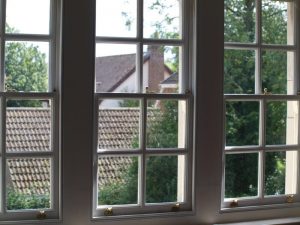
Sash windows are timeless and elegant features that enhance the look of any home, modern or antique. Here you can learn all about the history, style, and restoration of sash windows, when to have them replaced and how to choose new sashes. If you are in the process of renovating a Regency, Victorian, or Georgian property, this article could be of interest to you.
What Are Sash Windows and How Do They Work?
A sash window, also known as a hung sash window, consists of one or two movable sashes or panels that form a frame to hold the glass and framework around the glass in place. A sliding sash window consists of two sliding sashes that can be moved up and down. A typical sash window consists of a number of individual parts that include sash weights, top and bottom rails, a sill, timber linings, and cords. These parts work in harmony to facilitate the proper movement and functionality of the window unit and contribute to the unique look and aesthetic value of sash windows.
To facilitate the movement of a sash window, the glazed panel or sash is balanced by a counterweight made of steel, lead, or cast iron connected to the window by a sash cord. This is usually an attractive braided cord that runs over the top of a pulley and along the top of the rail. A bottom rail completes the window design and wagtails are used to separate the weights and provide a smooth movement. The cords are concealed within the hollow box frame of older windows. Insulation can be retrofitted into the pockets of these windows. This classic sash window design was common in Victorian and Georgian properties but can also be found with some variations in certain Edwardian and late Victorian homes.
Sash Window Styles
When renovating an old property or deciding on a design for a period-style home it is important to establish the right time period. Because there were several developments in sash window styles over the years it is easy to get caught out.
Traditionally, sash windows consisted of a number of small panes or lights which were held together by glazing or astragal bars. This created a larger glazed area at a time period when glass advancements did not include very large expanses of clear glass.
Should You Repair or Replace Your Sash Windows?
In order to maintain the authentic look of period sash windows, it is important to avoid removing the original timber sashes and replacing them with modern models. Where possible, always try to restore and waterproof the original window sashes.
Benefits of Repair Where Possible:
- The home will retain its original charm and character. – The timber used in original window sashes is generally of a much higher quality than the materials available today.
- If the box frame is retained and the glazing replaced, homeowners will benefit from the improved thermal performance that double glazing and draught-proofing provide.
Cost of Restoring or Replacing Sash Windows
If the original frames are salvageable it is possible to replace the glazing in sash windows. Single-glazed panels can be upgraded with slim, double-glazing if the frames can be renovated to a good condition. Finally, new sashes can be fitted into the existing window frames. Window repair specialists estimate a cost of anything from £1,000 and upwards per window.
Replacement Sash Window Materials?
Timber Sash Windows
Original timber sash windows are almost always the first and only choice for traditionalists, listed buildings, or for properties in a Conservation Area. Unfortunately plastic materials will never be able to provide the same tactile effect. Timber sash windows are highly durable with excellent insulation and will last a long time if properly maintained.
PVCu Sash Windows
Also referred to as uPVC, PVCu sash windows are a popular choice for substituting painted wood. Most commonly found in white, they also come in a variety of colours including a photo-effect wood finish. They are energy efficient, although not sustainable as they are not recyclable, and they need little maintenance.
Composite Sash Windows
Composite sash windows are becoming more popular with modern versions that feature a timber interior and aluminium cladding on the outside. Composite sash windows are able to retain the classic timber look on the inside while the exterior materials are extremely low-maintenance.
Glazing in Sash Windows
Because the latest building regulations make it almost impossible to install single glazed windows in new homes you may have to sacrifice the true authenticity that sash windows offer. However, it is still possible to have single-glazed windows installed with renovations of certain properties.
Double Glazing in Sash Windows
Thick bars that are used to divide small units of double glazing or secondary glazing can look clumsy; however, there are effective ways to recreate fine glazing bars. The most effective way is to have mock bars bonded onto either side of a double glazed window. Another way is to add spacer bars between the glazing for effect but the cost will be higher.
Triple Glazed Sash Windows
Triple glazing in traditional sash windows is an available option; however, it comes at a premium cost associated with all triple glazed windows. Even so, modern triple glazing no longer carries the same cost stigma of the last couple of decades.